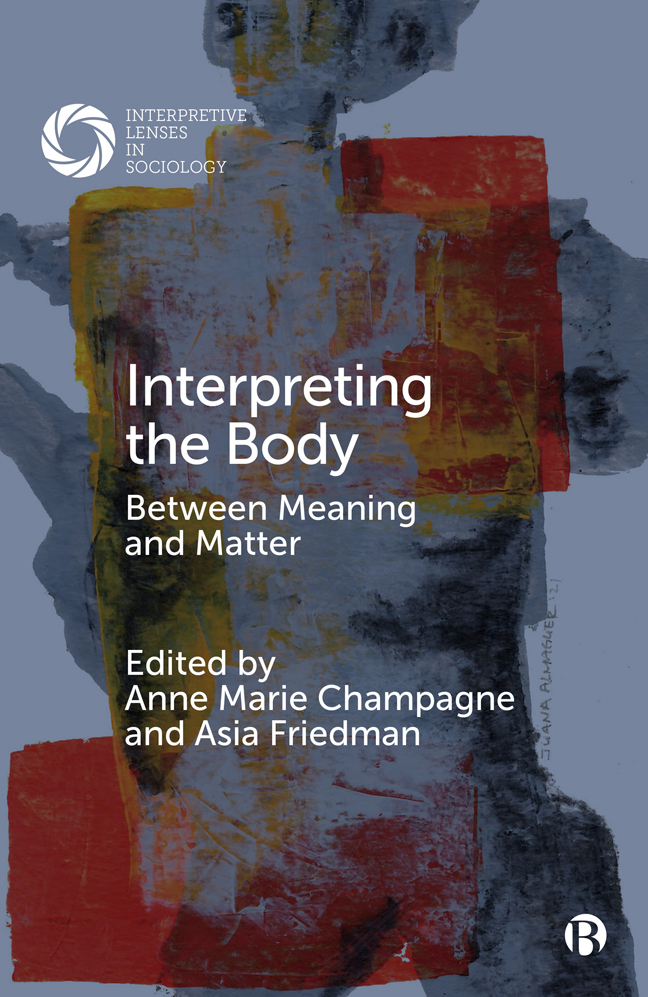Book contents
- Frontmatter
- Dedication
- Contents
- Series Editors’ Preface: Interpretive Lenses in Sociology—On the Multidimensional Foundations of Meaning in Social Life
- Notes on Contributors
- Preface and Acknowledgments
- Introduction: Between Meaning and Matter
- 1 Toward a Strong Cultural Sociology of the Body and Embodiment
- 2 Thinking the Molecular
- 3 Interpreting Africa's Seselelãme: Bodily Ways of Knowing in a Globalized World
- 4 Gender on the Post-Colony: Phenomenology, Race, and the Body in Nervous Conditions
- 5 Reinterpreting Male Bodies and Health in Crisis Times: From “Obesity” to Bigger Matters
- 6 Beauty, Breasts, and Meaning after Mastectomy
- 7 “You Are Not the Body”: (Re)Interpreting the Body in and through Integral Yoga
- 8 Black Girls’ Bodies and Belonging in the Classroom
- 9 Embodied Vulnerability and Sensemaking with Solidarity Activists
- 10 Our Bodies, Our Disciplines, Our Selves
- Index
1 - Toward a Strong Cultural Sociology of the Body and Embodiment
Published online by Cambridge University Press: 23 January 2024
- Frontmatter
- Dedication
- Contents
- Series Editors’ Preface: Interpretive Lenses in Sociology—On the Multidimensional Foundations of Meaning in Social Life
- Notes on Contributors
- Preface and Acknowledgments
- Introduction: Between Meaning and Matter
- 1 Toward a Strong Cultural Sociology of the Body and Embodiment
- 2 Thinking the Molecular
- 3 Interpreting Africa's Seselelãme: Bodily Ways of Knowing in a Globalized World
- 4 Gender on the Post-Colony: Phenomenology, Race, and the Body in Nervous Conditions
- 5 Reinterpreting Male Bodies and Health in Crisis Times: From “Obesity” to Bigger Matters
- 6 Beauty, Breasts, and Meaning after Mastectomy
- 7 “You Are Not the Body”: (Re)Interpreting the Body in and through Integral Yoga
- 8 Black Girls’ Bodies and Belonging in the Classroom
- 9 Embodied Vulnerability and Sensemaking with Solidarity Activists
- 10 Our Bodies, Our Disciplines, Our Selves
- Index
Summary
For the task of intellectuals is not only to explain the world; they must interpret it as well.
— Jeffrey C. Alexander, The Meanings of Social Life: A Cultural SociologyFormerly noteworthy for its muted absence from sociological theory, the body with which contemporary theory concerns itself is no less remarkable despite it no longer being silent or absent (Williams and Bendelow, 1998; Shilling, 2012). Since the corporeal turn in sociology in the 1980s, considerable attention has been given to body studies across multiple academic disciplines within the humanities and social sciences (Shilling, 2016). As with other epistemic shifts, this turn has led to a proliferation of approaches to understanding the social ontology of the body and its constitutive role in the embodiment and production of social life and the self. Many of these approaches—including, among others, the culturally pragmatic (see Champagne, 2018; Broch, 2020), phenomenological (see Merleau-Ponty, 1945; Leder, 1990; Csordas, 1994; Young, 2005), interactionist (see Waskul and Vannini, 2006), and praxeological (see Goffman, 1959; Garfinkel, 1967; Bourdieu, 1977; Foucault, 1978b; Butler, 1990)—highlight the body's embedment in symbolic horizons of meaning. Yet, in spite of sharing a common interest in the cultural dimensions of the body and embodiment, there is scarcely agreement among scholars working within these traditions about what culture is (is it a fairly stable system of shared meanings or an emergent property of social interaction?), where it is located (in the mind or among things?), and whether it has ordering power (does it play a powerful or feeble role in structuring social life?). Neither is there a settled consensus regarding the role interpretation plays in constituting the “landscapes of meaning” (Reed, 2011, p 92) that shape and transform a person's sense of the social world nor the bodies and embodiments that may co-constitute that landscape. Is the body a “sign-bearing, sign-wearing” (Bourdieu, 1984, p 190) surface off of which we unconsciously read social-symbolic value? Or is it also a fecund reservoir of sensibility and imagination from which culture's webs of signification are spun (Geertz, 1973)? Is the body determined by actions alone or is it something one completes through meaning-making (Turner, 1991)?
The dissensus I have outlined here, while hardly exhaustive, is representative of outstanding debates regarding the relative autonomy of culture (Alexander and Smith, 2003).
- Type
- Chapter
- Information
- Interpreting the BodyBetween Meaning and Matter, pp. 19 - 43Publisher: Bristol University PressPrint publication year: 2023



